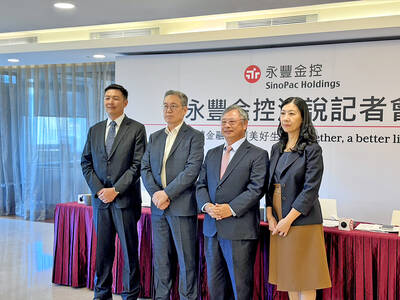Taiwan and Thailand might be added to the US watch list for currency manipulation after meeting all of the criteria set out by the US Department of the Treasury, UBS Group AG has said.
A country is included in the monitoring list if it fulfills two of three benchmarks: a trade surplus with the US of at least US$20 billion; a current-account surplus of at least 2 percent of GDP; and persistent, one-sided intervention in the currency equivalent to 2 percent of GDP in six months of a year.
Taiwan, which dropped off the US monitoring list in 2017, and Thailand now fulfill all three criteria, UBS’ analysis shows.
Neither were included in the department’s January findings.
“Thailand and Taiwan crossed the US$20 billion trade surplus mark to make it to the list,” UBS strategists, including Rohit Arora and Teck Quan Koh, wrote in a report on Tuesday. “We expect Thailand’s inaugural mention in the upcoming report, with a non-negligible possibility of Taiwan’s re-mention.”
In Taipei, central bank Governor Yang Chin-long (楊金龍) has said that Taiwan might appear on the watch list if the US keeps its criteria.
“Our principle of when to step in forex market does not change, that is when there is huge fund flow in or out in short period of time. The central bank will maintain the stability of Taiwan dollar,” he said last month.
Bank of Thailand (BOT) Governor Veerathai Santiprabhob said on Tuesday last week that he is not concerned about the upcoming report, as the nation has explained its foreign-exchange policy to the department.
The baht has moved in both directions against the US dollar and actually weakened from last year, he said.
He added that the BOT only steps in when there are excessive swings, as it uses a managed float system and the department understands that.
The US dropped its designation of China as a currency manipulator in its last report, noting the world’s second-biggest economy had made “enforceable commitments” not to devalue the yuan.
Switzerland was added to the watch list, while China, Japan, South Korea, Germany, Italy, Ireland, Singapore, Malaysia, Vietnam were retained.
About 75 percent of central banks have engaged in “persistent FX intervention,” the UBS report found.
Asian nations made up about 60 percent of the economies under currency surveillance by the department, the strategists said.
“Even though we think no country will be labeled a manipulator, the report matters symbolically for FX markets,” the UBS strategists wrote.
“A persistent one-sided intervention means authorities may have to focus on current-account surplus recycling flows or structural reforms to avoid any unintended penalties over the medium term,” the strategists wrote.
Here are some of UBS’ other findings:
‧Taiwan’s inclusion in the list might be a “close call” on the nation’s strengthening currency and transparent disclosures around forwards positions.
‧The BOT is estimated to have intervened 10 out of 12 months in the currency market over the course of last year, with net foreign-exchange purchases representing 3.5 percent of GDP.
‧COVID-19 disruption in Thailand’s tourism sector and impact on current-account might curb the BOT’s opportunities to buy US dollars over next six to nine months.

On Tuesday, US President Donald Trump weighed in on a pressing national issue: The rebranding of a restaurant chain. Last week, Cracker Barrel, a Tennessee company whose nationwide locations lean heavily on a cozy, old-timey aesthetic — “rocking chairs on the porch, a warm fire in the hearth, peg games on the table” — announced it was updating its logo. Uncle Herschel, the man who once appeared next to the letters with a barrel, was gone. It sparked ire on the right, with Donald Trump Jr leading a charge against the rebranding: “WTF is wrong with Cracker Barrel?!” Later, Trump Sr weighed

SinoPac Financial Holdings Co (永豐金控) is weighing whether to add a life insurance business to its portfolio, but would tread cautiously after completing three acquisitions in quick succession, president Stanley Chu (朱士廷) said yesterday. “We are carefully considering whether life insurance should play a role in SinoPac’s business map,” Chu told reporters ahead of an earnings conference. “Our priority is to ensure the success of the deals we have already made, even though we are tracking some possible targets.” Local media have reported that Mercuries Life Insurance Co (三商美邦人壽), which is seeking buyers amid financial strains, has invited three financial

HEADWINDS: Upfront investment is unavoidable in the merger, but cost savings would materialize over time, TS Financial Holding Co president Welch Lin said TS Financial Holding Co (台新新光金控) said it would take about two years before the benefits of its merger with Shin Kong Financial Holding Co (新光金控) become evident, as the group prioritizes the consolidation of its major subsidiaries. “The group’s priority is to complete the consolidation of different subsidiaries,” Welch Lin (林維俊), president of the nation’s fourth-largest financial conglomerate by assets, told reporters during its first earnings briefing since the merger took effect on July 24. The asset management units are scheduled to merge in November, followed by life insurance in January next year and securities operations in April, Lin said. Banking integration,

Artificial intelligence (AI) chip designer Cambricon Technologies Corp (寒武紀科技) plunged almost 9 percent after warning investors about a doubling in its share price over just a month, a record gain that helped fuel a US$1 trillion Chinese market rally. Cambricon triggered the selloff with a Thursday filing in which it dispelled talk about nonexistent products in the pipeline, reminded investors it labors under US sanctions, and stressed the difficulties of ascending the technology ladder. The Shanghai-listed company’s stock dived by the most since April in early yesterday trading, while the market stood largely unchanged. The litany of warnings underscores growing scrutiny of